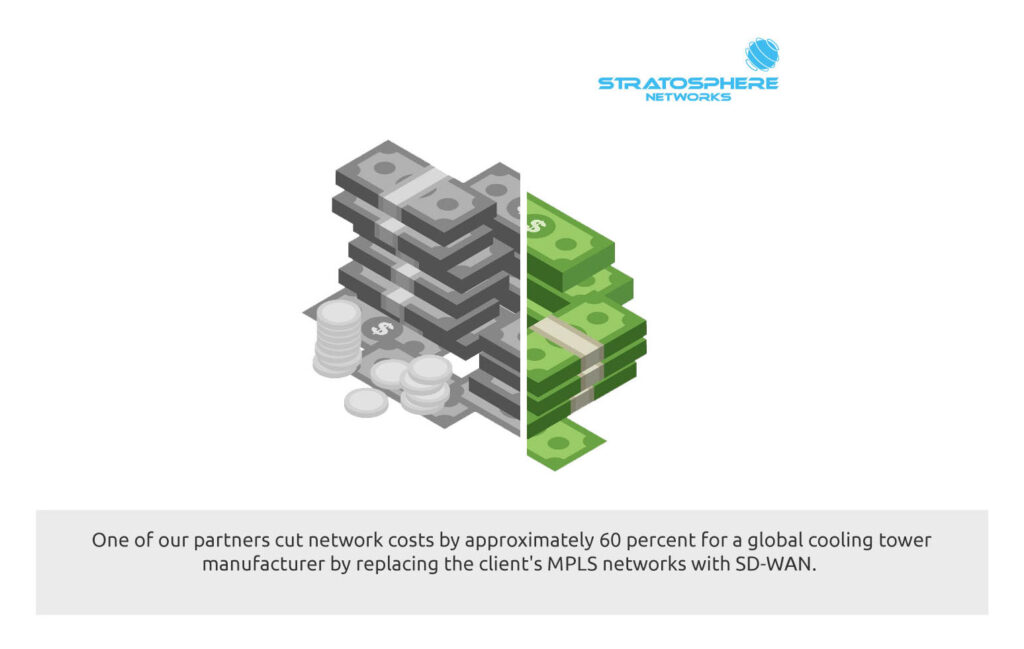
Meanwhile, the European offices often relocated, but the IT team needed months to move the MPLS circuits. On top of all that, the company didn’t have direct control over the network technology’s firewalls, posing security concerns, and the three different interfaces interfered with troubleshooting. Overall, the time it took to adjust the MPLS circuits in response to new developments (e.g., remote work arrangements) meant the company lacked agility.
Our partner replaced the MPLS networks with SD-WAN, which not only reduced costs by roughly 60 percent but also significantly boosted capacity. For example, in Australia, their bandwidth went from 20 Mbps to 50 Mbps. In California, it shot up from 10 Mbps to 50. The client also gained visibility into the network and greater control over security via the solution provider. Agility skyrocketed since the manufacturer can now respond to issues and make changes instantly via a portal and real-time events page.
Like the cooling tower manufacturer, many businesses have migrated from MPLS to SD-WAN for superior network performance and enhanced security, particularly as remote work has become prevalent. If you currently rely on MPLS and aren’t happy with your network, here are some reasons to make a move and switch to SD-WAN.
1. It’s less expensive.
With MPLS, remote locations are typically connected to a data center via individual connections in a hub-and-spoke arrangement, according to Fortinet. As a result, all workflows, transactions, and data get backhauled to that data center. On the other hand, SD-WAN allows you to prioritize data based on type and identify the most cost-effective and fastest path for it via various transport methods (e.g., direct broadband internet, MPLS, and LTE/5G), as Cisco explains.
2. SD-WAN is generally more secure.
With MPLS, all application traffic must undergo security inspection at the central data center, according to Palo Alto Networks. Locations with intra- or inter-branch traffic require their own security solutions to achieve threat protection.
Meanwhile, SD-WAN allows application security at branches, the data center, or the cloud, and SD-WAN appliances commonly have the ability to secure intra- and inter-branch traffic security. On top of that, you can achieve end-to-end protection with SD-WAN with encrypted overlay tunnels leading to the cloud or data centers.
3. SD-WAN offers more flexibility and better network performance.
With MPLS, you receive a fixed amount of bandwidth, according to Fortinet. That means you must either pay for much more than you typically need or lack capacity during traffic surges. SD-WAN is smart enough to recognize the type of traffic it’s dealing with and dynamically adjusts bandwidth, prioritizing applications like voice and video software with low-latency requirements.
It’s important to note that data and applications necessitating high levels of privacy and integrity might be better suited to MPLS than SD-WAN, according to Fortinet. However, MPLS can be one of the available transport options for your SD-WAN solution, which means you can leverage both technologies at the same time for maximum security, performance, and affordability.
4. It’s more scalable.
Because SD-WAN aggregates various transport methods, it’s easier to add bandwidth when necessary, compared to MPLS, according to Check Point. As a result, it makes sense to deploy SD-WAN if your company is growing and you anticipate needing to rapidly scale up bandwidth.
Our consultants can assist you if you want expert insights into the best networking technology for your business. With our 20+ years of experience in IT, extensive partner network, and access to advanced tools, we can rapidly identify the best option for your organization after evaluating your pain points, needs and goals. Our clients typically save dozens of hours they would have spent vetting suppliers and products on their own. Simplify the process by allowing us to do the homework for you.
Start your transformation today by calling 877-599-3999 or emailing sales@stratospherenetworks.com to connect with our technology consultants.



